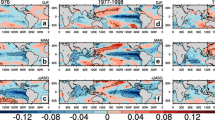Abstract
The near-equatorial (0°–5°N) tropical cyclones (TCs) in the western North Pacific (WNP) exhibit distinctive seasonal variability, with a peak in the boreal winter, as opposite to that in the main TC development region over the WNP. The mechanism behind such a distinctive annual evolution is investigated through the diagnosis of the genesis potential index (GPI). By isolating the effect of various environmental parameters, we found that the increase of the near-equatorial GPI in the boreal winter is primarily attributed by the low-level absolute vorticity. As the season progresses from the boreal summer to winter, the northeasterly trade wind turns anticlockwise near the equator, leading to maximum low-level cyclonic vorticity near 5°N. In addition, the mean flow advection also plays a role in “allowing” more time for perturbations to grow in the near-equatorial zone in DJFMAM than in JASO. The seasonal changes of other environmental conditions, such as relative humidity and sea surface temperature, are not as critical. While the effect of area-averaged vertical wind shear is small due to the opposite signs between western and eastern sectors of the WNP in the boreal winter, a moderate vertical shear over 140–160°E, 2–5°N may favor the development of TC-like disturbances in the region. Our analysis results suggest that dynamic parameters are more important for the formation of near-equatorial TCs.








Similar content being viewed by others
References
Anthes RA (1982) Tropical cyclone: their evolution, structure and effects. Meteorol Monogr: 208
Chambers CRS, Li T (2007) Simulation of formation of a near-equatorial typhoon Vamei (2001). Meteorol Atmos Phys 98(1):67–80
Chang CP, Liu CH, Kuo HC (2003) Typhoon Vamei: an equatorial tropical cyclone formation. Geophys Res Let 30(3):1151–1154
Dee DP, Coauthors (2011) The ERA-Interim reanalysis: Configuration and performance of the data assimilation system. Quart J Roy Meteor Soc 137:553–597
Demaria M (1996) The effect of vertical shear on tropical cyclone intensity change. J Atmos Sci 53:2076–2087
Emanuel KA (2000) A statistical analysis of tropical cyclone intensity. Mon Weather Rev 128:1139–1152
Emanuel KA, Nolan DS (2004) Tropical cyclone activity and global climate. In: 26th Conf. on Hurricanes and Tropical Meteorology, Miami, FL, Amer Meteor Soc, 240–241 (Preprints)
Fortner LE (1958) Typhoon Sarah. 1956. Bull Amer Meteor Soc 39:633–639
Frank WM, Ritchie EA (2001) Effects of vertical wind shear on the intensity and structure of numerically simulated hurricanes. Mon Weather Rev 129:2249–2269
Fu B, Peng MS, Li T, Stevems DE (2012) Developing versus nondeveloping disturbances for tropical cyclone formation. Part II: Western North Pacific. Mon Weather Rev 140:1067–1080
Gray WM (1968) Global view of the origin of tropical disturbances and storms. Mon Weather Rev 96:669–700
Gray WM, (1979) Hurricanes: their formation, structure and likely role in the tropical circulation. Meteorology over the tropical oceans. James Glaisher House 155–218
Holliday CR, Thompson AH (1986) An unusual near-equatorial typhoon. Mon Weather Rev 114:2674–2677
Juneng L, Tangang FT, Reason CJC, Moten S, Hassan WAW (2007) Simulation of tropical cyclone Vamei (2001) using the PSU/NCAR MM5 model. Meteorol Atmos Phys 97(1):273–290
Li T (2012) Synoptic and climatic aspects of tropical cyclogenesis in Western North Pacific. In: Oouchi K, Fudeyasu H (eds) Chapter 3. Nova Science Publishers, Inc, pp 61–94
Li T, Hsu P-C (2017) Chapter 4 tropical cyclone formation fundamentals of tropical climate dynamics. Springer atmospheric sciences. https://doi.org/10.1007/978-3-319-59597-9$44
Li T, Ge X, Peng M, Wang W (2012) Dependence of tropical cyclone intensification on the Coriolis parameter. Trop Cyclone Res Rev 1(2):242–253
Li Z, Yu WD, Li T, Murty VSN, Tang G, Fredolin (2013) Bimodal character of cyclone climatology in the Bay of Bengal modulated by monsoon seasonal cycle. J Clim 26:1033–1046
Murakami H, Wang B (2010) Future change of North Atlantic tropical cyclone tracks: projection by a 20-km-mesh global atmospheric model. J Clim 23:2699–2721
Peng MS, Fu B, Li T, Stevens DE (2012) Developing versus nondeveloping disturbances for tropical cyclone formation. Part 1: North Atlantic. Mon Wea Rev 140:1047–1066
Reynolds RW, Smith TM, Liu C, Chenlton DB, Casey KS, Schlax MG (2007) Daily high-resolution-blended analyses for sea surface temperature. J Clim 20:5473–5496
Wong MLM, Chan JCL (2004) Tropical cyclone intensity in vertical wind shear. J Atmos Sci 61:1859–1876
Yi BQ, Zhang QH (2010) Near-equatorial typhoon development: climatology and numerical simulations. Adv Atmos Sci 27(5):1014–1024
Acknowledgements
This study is jointly supported by the China National 973 projects (2017YFA0603802 and 2015CB453200), the NSF of China (Grants 41775058 and 41630423), NRL grant N00173-16-1-G906, NSF AGS-16-43297, Jiangsu NSF project (BK20150062), and the Priority Academic Program Development of Jiangsu Higher Education Institutions (PAPD). This is SOEST contribution number 10407, IPRC contribution number 1324 and ESMC number 219.
Author information
Authors and Affiliations
Corresponding author
Rights and permissions
About this article
Cite this article
Li, Y., Li, T., Fu, C. et al. Near-equatorial tropical cyclone formation in western North Pacific: peak season and controlling parameter. Clim Dyn 52, 2765–2773 (2019). https://doi.org/10.1007/s00382-018-4291-3
Received:
Accepted:
Published:
Issue Date:
DOI: https://doi.org/10.1007/s00382-018-4291-3




